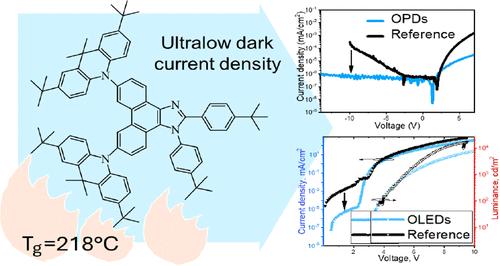当前位置:
X-MOL 学术
›
ACS Appl. Electron. Mater.
›
论文详情
Our official English website, www.x-mol.net, welcomes your
feedback! (Note: you will need to create a separate account there.)
Ultralow Dark Current Density of Organic Photodetectors and Organic Light-Emitting Diodes Endowed by Highly Thermally Stable Derivatives of 2,7-Di-tert-butyl-9,9-dimethyl-9,10-dihydroacridine and Phenanthroimidazole Exhibiting Balanced Bipolar Charge Transport
ACS Applied Electronic Materials ( IF 4.3 ) Pub Date : 2024-06-13 , DOI: 10.1021/acsaelm.4c00746 Rita Butkute 1 , Ausrine Masiulyte 1 , Ehsan Ullah Rashid 1 , Svetlana Sargsyan 2 , Neelalohith Satish Moudgalya 1 , Karolis Leitonas 1 , Dmytro Volyniuk 1 , Juozas V. Grazulevicius 1
ACS Applied Electronic Materials ( IF 4.3 ) Pub Date : 2024-06-13 , DOI: 10.1021/acsaelm.4c00746 Rita Butkute 1 , Ausrine Masiulyte 1 , Ehsan Ullah Rashid 1 , Svetlana Sargsyan 2 , Neelalohith Satish Moudgalya 1 , Karolis Leitonas 1 , Dmytro Volyniuk 1 , Juozas V. Grazulevicius 1
Affiliation

|
Seeking to develop more advanced organic photodetectors (OPDs) and organic light-emitting diodes (OLEDs), we designed three derivatives of 2,7-di-tert-butyl-9,9-dimethyl-9,10-dihydroacridine and phenanthroimidazole with either −CF3 or −C(CH3)3 groups. These compounds were synthesized by Buchwald–Hartwig amination reaction with yields of up to 77%. They show high glass transition temperatures above 200 °C and balanced electron and hole transport with mobilities of up to 10–3 cm2/V·s under strong electric fields. One compound with −C(CH3)3 groups outperformed the standard host material in the OLED, which showed 17% higher external quantum efficiency. The low dark current density resulted in enhanced efficiency of OLEDs due to minimal charge leakage. Compared to the commercial material 1,1-bis[(di-4-tolylamino)phenyl]cyclohexane (TAPC), this compound allowed achieving superior photosensitivity in OPDs. The photocurrent to dark current density ratio at a reverse voltage of −10 V was found to be 6000. For TAPC-based OPDs, this ratio was only 43.3. The dark current density was significantly reduced to 4.5 × 10–7 mA·cm–2, compared to 3 × 10–4 mA·cm–2 for TAPC-based OPDs at the same reverse voltage, thus enhancing the photosensitivity of the OPDs.
中文翻译:

2,7-二叔丁基-9,9-二甲基-9,10-二氢吖啶和菲咪唑的高热稳定性衍生物赋予有机光电探测器和有机发光二极管超低暗电流密度,表现出平衡的双极电荷传输
为了开发更先进的有机光电探测器(OPD)和有机发光二极管(OLED),我们设计了 2,7-二叔丁基-9,9-二甲基-9,10-二氢吖啶和菲并咪唑的三种衍生物,其中-CF 3 或 -C(CH 3 ) 3 基团。这些化合物通过 Buchwald-Hartwig 胺化反应合成,收率高达 77%。它们表现出高于 200 °C 的高玻璃化转变温度以及平衡的电子和空穴传输,在强电场下迁移率高达 10 –3 cm 2 /V·s。一种带有 -C(CH 3 ) 3 基团的化合物在 OLED 中的性能优于标准主体材料,其外量子效率提高了 17%。由于电荷泄漏极小,低暗电流密度提高了 OLED 的效率。与商业材料 1,1-双[(二-4-甲苯氨基)苯基]环己烷 (TAPC) 相比,该化合物可以在 OPD 中实现优异的光敏性。反向电压为-10 V 时,光电流与暗电流密度之比为 6000。对于基于 TAPC 的 OPD,该比率仅为 43.3。暗电流密度显着降低至 4.5 × 10 –7 mA·cm –2 ,而 3 × 10 –4 mA·cm –2 对于基于 TAPC 的 OPD,在相同的反向电压下,从而增强 OPD 的光敏性。
更新日期:2024-06-13
中文翻译:

2,7-二叔丁基-9,9-二甲基-9,10-二氢吖啶和菲咪唑的高热稳定性衍生物赋予有机光电探测器和有机发光二极管超低暗电流密度,表现出平衡的双极电荷传输
为了开发更先进的有机光电探测器(OPD)和有机发光二极管(OLED),我们设计了 2,7-二叔丁基-9,9-二甲基-9,10-二氢吖啶和菲并咪唑的三种衍生物,其中-CF 3 或 -C(CH 3 ) 3 基团。这些化合物通过 Buchwald-Hartwig 胺化反应合成,收率高达 77%。它们表现出高于 200 °C 的高玻璃化转变温度以及平衡的电子和空穴传输,在强电场下迁移率高达 10 –3 cm 2 /V·s。一种带有 -C(CH 3 ) 3 基团的化合物在 OLED 中的性能优于标准主体材料,其外量子效率提高了 17%。由于电荷泄漏极小,低暗电流密度提高了 OLED 的效率。与商业材料 1,1-双[(二-4-甲苯氨基)苯基]环己烷 (TAPC) 相比,该化合物可以在 OPD 中实现优异的光敏性。反向电压为-10 V 时,光电流与暗电流密度之比为 6000。对于基于 TAPC 的 OPD,该比率仅为 43.3。暗电流密度显着降低至 4.5 × 10 –7 mA·cm –2 ,而 3 × 10 –4 mA·cm –2 对于基于 TAPC 的 OPD,在相同的反向电压下,从而增强 OPD 的光敏性。

































 京公网安备 11010802027423号
京公网安备 11010802027423号